Un plugin specifico per il sito consente di aggiungere facilmente snippet di codice al sito WordPress senza dipendere dal tema. Permette di utilizzare il codice personalizzato per migliorare il sito senza preoccuparsi di dover rifare tutto quando il tema viene aggiornato.
Noi di WPBeginner abbiamo creato molti plugin specifici per il sito per aggiungere shortcode, nuovi tipi di post e altre funzionalità al nostro sito. Inoltre, abbiamo anche aiutato i nostri clienti a iniziare con plugin specifici per il sito.
In questo articolo spiegheremo come creare un plugin WordPress specifico per il sito e perché è importante.
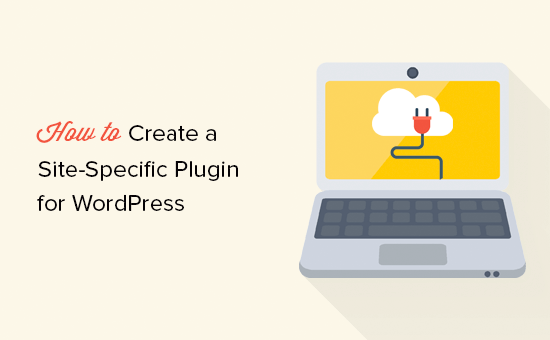
Che cos’è un plugin WordPress specifico per il sito?
Un plugin WordPress specifico per il sito è un plugin autonomo che si può utilizzare per aggiungere tutti gli snippet di personalizzazione che non dipendono dal tema.
Quando si lavora sul proprio sito web, spesso si trovano tutorial di WordPress che chiedono di aggiungere codice al file functions.php del proprio tema o a un plugin specifico per il sito.
WordPress non è dotato di un plugin specifico per il sito. È necessario crearne uno proprio e poi installarlo e attivarlo.
Perché creare un plugin WordPress specifico per il sito?
Come abbiamo detto in precedenza, spesso ci si imbatte in tutorial che mostrano un codice da aggiungere al file functions.php del proprio tema o a un plugin specifico per il sito.
Questi codici personalizzati possono essere utilizzati per aggiungere nuovi tipi di post, tassonomie, shortcode e tonnellate di hack per migliorare il vostro sito web.
Se si aggiunge il codice personalizzato al file delle funzioni del tema, esso scomparirà se si aggiorna o si cambia tema.
È possibile creare un tema figlio e utilizzare il file di funzioni del tema figlio per salvare il codice. Tuttavia, il codice scomparirà comunque se si cambia tema.
Un plugin WordPress specifico per il sito consente di aggiungere facilmente snippet di codice personalizzati al sito WordPress e di assicurarsi che siano indipendenti dal tema. Si tratta di un plugin WordPress autonomo, il che significa che non dipende dal vostro tema e che siete liberi di aggiornare o cambiare il vostro tema.
Detto questo, vediamo come aggiungere facilmente codice personalizzato utilizzando un plugin specifico per il sito. Vi mostreremo due modi per farlo e potrete scegliere il metodo più adatto a voi (suggerimento: il metodo #2 è più facile per i principianti).
Metodo 1: Creare manualmente un plugin WordPress specifico per il sito
Sappiamo che per i principianti tutto ciò può sembrare un po’ da smanettoni, ma cercheremo di renderlo il più semplice possibile.
Innanzitutto, è necessario creare una nuova cartella sul desktop e assegnarle il nome del proprio sito web. Ad esempio: mywebsite-plugin.
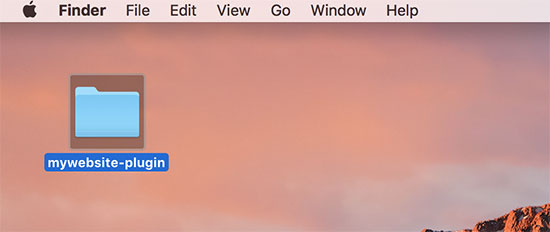
A questo punto, aprire un editor di testo semplice sul computer, come Notepad o TextEdit.
È necessario creare un nuovo file e salvarlo come mywebsite-plugin.php nella cartella dei plugin sul desktop.
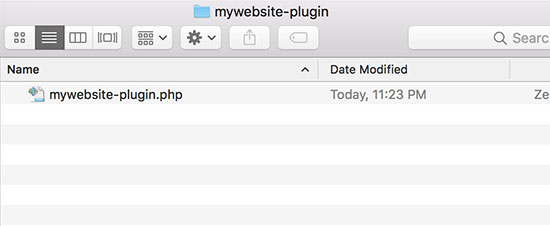
Il file del plugin ha bisogno di un codice di intestazione specifico, in modo che WordPress possa riconoscerlo come plugin. Aggiungete il seguente codice al file mywebsite-plugin.php:
1 2 3 4 5 6 7 8 9 | <?php/*Plugin Name: Site Plugin for example.comDescription: Site specific code changes for example.com*//* Start Adding Functions Below this Line *//* Stop Adding Functions Below this Line */?> |
È possibile sostituire example.com con il proprio nome di dominio. Una volta fatto questo, il plugin specifico per il sito è pronto.
Ci sono due modi per caricare il plugin specifico per il sito sul vostro sito web. Potete caricarlo tramite il pannello di amministrazione di WordPress o utilizzare l’FTP.
1. Installare il plugin specifico per il sito dall’area amministrativa di WordPress (consigliato)
Questo metodo è più semplice e consigliato a tutti gli utenti.
Per prima cosa, è necessario creare un file zip della cartella del plugin specifico del sito.
Gli utenti di Windows possono semplicemente fare clic con il tasto destro del mouse sulla cartella del plugin e selezionare Invia a ” cartella compressa (zip).
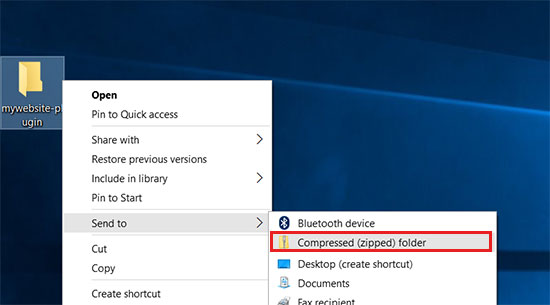
Gli utenti Mac devono fare clic con il tasto destro del mouse.
Quindi, selezionare “Comprimi il mio sito-plugin”.
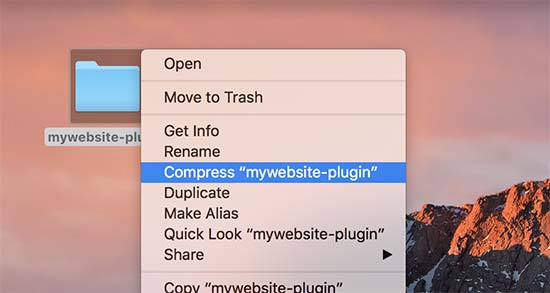
Una volta ottenuto il file zip del plugin, andare alla pagina Plugin ” Aggiungi nuovo nell’area di amministrazione di WordPress.
Quindi fare clic sul pulsante “Carica plugin” in alto.
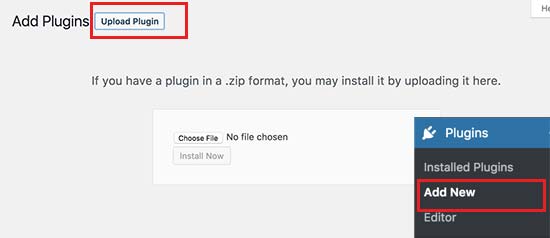
Quindi, fare clic sul pulsante “Scegli file” per selezionare il file zip creato in precedenza, quindi fare clic sul pulsante “Installa ora”.
WordPress caricherà e installerà il plugin per voi. Una volta caricato, è necessario fare clic sul pulsante “Attiva plugin” per iniziare a utilizzare il plugin specifico del sito.
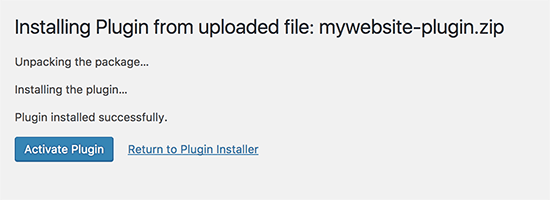
2. Caricare il plugin WordPress specifico per il sito tramite FTP
Per questo metodo, non è necessario creare un file zip. Il plugin verrà caricato tramite FTP.
Per prima cosa, è necessario collegarsi al proprio sito web utilizzando un client FTP.
Una volta connessi, andare alla cartella /wp-content/plugins/ nella colonna del sito remoto. Successivamente, è necessario selezionare la cartella dei plugin specifica del sito e caricarla sul proprio sito web.
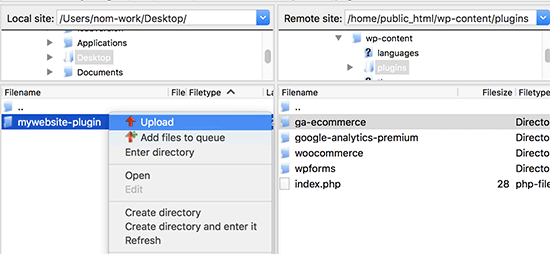
Il vostro client FTP trasferirà ora la cartella del plugin specifico per il sito al vostro sito web WordPress. Questo installerà il plugin sul vostro sito web.
Tuttavia, è necessario attivare il plugin per iniziare a utilizzarlo. È possibile farlo accedendo alla pagina “Plugin” nell’area di amministrazione di WordPress e facendo clic sul link “Attiva” sotto il plugin specifico del sito.
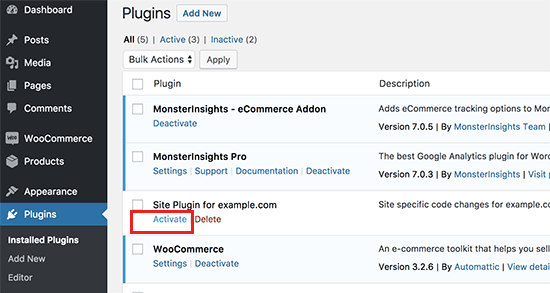
È tutto. Il vostro plugin specifico per il sito è ora pronto per essere utilizzato.
Aggiunta di snippet di codice personalizzati al plugin specifico del sito
Ci sono due modi per modificare il plugin e aggiungere snippet di codice personalizzati.
Il primo metodo consiste nel farlo tramite l’area di amministrazione di WordPress. Si può andare alla pagina Plugin ” Editor.
Verrà visualizzato un messaggio di avviso ed è necessario fare clic sul pulsante “Ho capito” per continuare. In alternativa, se volete un modo più sicuro per modificare i file, passate al secondo metodo qui sotto.
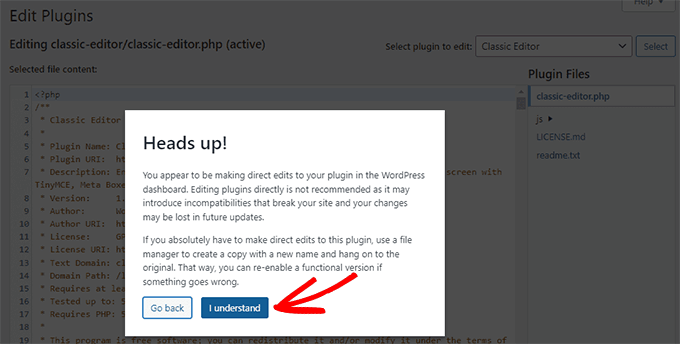
Successivamente, è necessario selezionare il plugin specifico del sito dal menu a discesa “Seleziona il plugin da modificare”.
L’editor caricherà il file del plugin e sarà possibile aggiungervi degli snippet di codice.
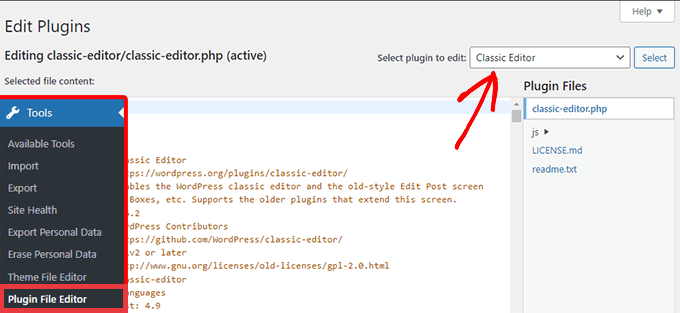
Al termine, fare clic sul pulsante “Aggiorna file” per salvare le modifiche.
Se manca qualcosa nel codice o se questo ha il potenziale di rompere il sito web, l’editor del plugin annullerà automaticamente le modifiche apportate.
Tuttavia, se l’editor non funziona e viene visualizzata la schermata bianca della morte, è possibile utilizzare FTP per modificare il file del plugin e annullare le modifiche.
Il secondo metodo consiste nel modificare direttamente il file del plugin tramite FTP. È sufficiente accedere alla cartella del plugin utilizzando il proprio client FTP. Fare clic con il tasto destro del mouse sul file del plugin e selezionare “Visualizza/Modifica”.
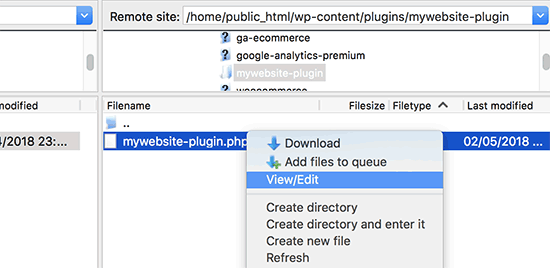
È anche possibile scaricare il file del plugin sul computer, modificarlo e caricarlo nuovamente.
Metodo 2: Aggiunta di codice personalizzato con WPCode (consigliato)
Questo metodo è molto più semplice e offre un modo migliore per gestire i singoli frammenti di codice in WordPress utilizzando WPCode.
La prima cosa da fare è installare e attivare il plugin gratuito WPCode sul vostro sito web. Per maggiori dettagli, consultate la nostra guida passo-passo su come installare un plugin di WordPress.
Articolo correlato: Per ulteriori informazioni, consultate la nostra recensione completa di WPCode.
Dopo l’attivazione, il plugin aggiunge una nuova voce di menu con l’etichetta “Code Snippets” al menu di amministrazione di WordPress. Facendo clic su di essa si accede a una pagina in cui è possibile gestire tutti i codici personalizzati.
Per aggiungere il primo frammento di codice, fare clic sul pulsante “Aggiungi nuovo”.
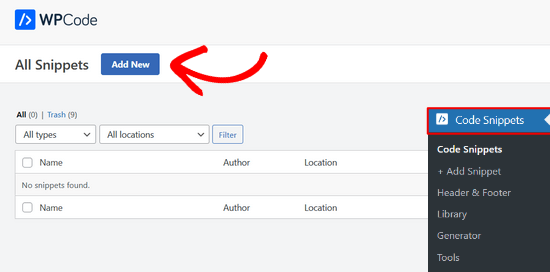
Si accede così alla pagina “Aggiungi snippet”. Qui è possibile scegliere uno snippet di codice dalla libreria predefinita o aggiungere il proprio codice personalizzato.
Per aggiungere il codice personalizzato, passare all’opzione “Aggiungi il tuo codice personalizzato (nuovo snippet)” e fare clic sul pulsante “Usa snippet”.
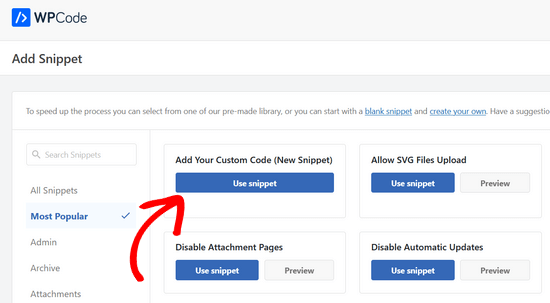
Ora è possibile inserire un titolo per lo snippet di codice personalizzato. Può essere qualsiasi cosa che aiuti a identificare il codice.
Dopodiché, si può procedere a incollare lo snippet di codice nella casella del codice. È inoltre necessario selezionare il tipo “Snippet PHP” dall’elenco a discesa “Tipo di codice” sulla destra.
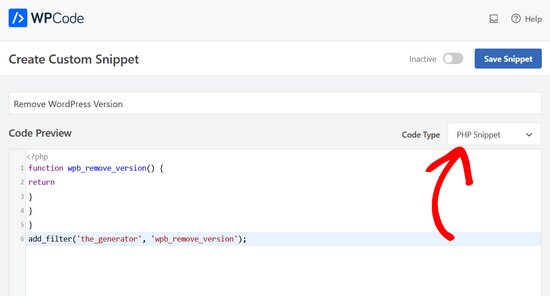
È inoltre possibile aggiungere note al codice nella sezione “Informazioni di base”.
In quest’area dovreste scrivere cosa fa questo codice, dove lo avete trovato e perché lo state aggiungendo al vostro sito web. Questo aiuterà il “futuro” a ricordare perché il “passato” ha aggiunto questo codice.
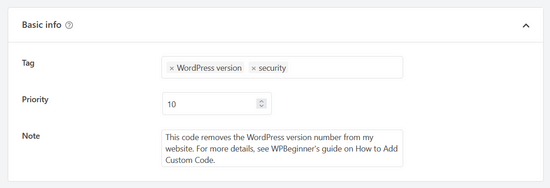
È inoltre possibile assegnare dei tag agli snippet di codice, che possono aiutare a organizzare gli snippet di codice per argomento e funzionalità.
Il plugin consente anche di selezionare la modalità di esecuzione dello snippet di codice. Nella sezione “Inserimento”, è possibile selezionare il metodo “Inserimento automatico” per inserire ed eseguire automaticamente il codice sul sito.
È possibile scegliere tra le opzioni dell’area di amministrazione, del front-end o di tutto il mondo. Se non si è sicuri, mantenere l’opzione predefinita “Esegui ovunque”.

Oppure si può scegliere il metodo ‘Shortcode’. Con questo metodo, lo snippet non viene inserito automaticamente. Una volta salvato lo snippet, si otterrà uno shortcode da inserire manualmente in qualsiasi punto del sito.
È inoltre possibile utilizzare la sezione “Logica condizionale intelligente” per mostrare o nascondere gli snippet inseriti automaticamente in base a una serie di regole.
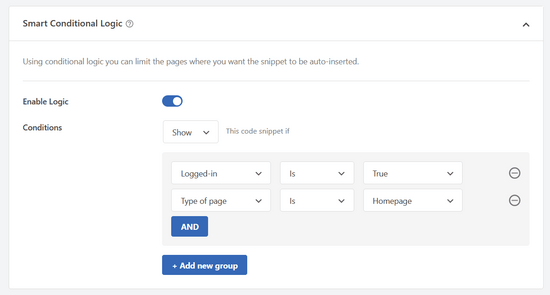
Ad esempio, è possibile caricare gli snippet di codice solo per gli utenti che hanno effettuato l’accesso, caricare gli snippet di codice PHP solo su URL di pagine specifiche, mostrare snippet di codice in base al tipo di pagina e altro ancora.
Infine, è possibile spostare l’interruttore da ‘Inattivo’ ad ‘Attivo’ e quindi fare clic sul pulsante ‘Salva frammento’.

Se si desidera salvare lo snippet di codice senza attivarlo, è possibile fare clic solo sul pulsante ‘Salva snippet’.
Una volta salvato e attivato uno snippet di codice, questo diventerà automaticamente effettivo sul vostro sito web, se questo è il metodo di inserimento che avete scelto.
Per maggiori dettagli, consultate la nostra guida su come aggiungere facilmente snippet di codice personalizzati in WordPress.
Speriamo che questo articolo vi abbia aiutato a capire perché e come creare un plugin WordPress specifico per un sito. Potreste anche voler consultare il nostro elenco di utili suggerimenti per i file di funzioni e gli hack WordPress più ricercati per utilizzare al meglio il vostro plugin specifico per il sito.
Se questo articolo vi è piaciuto, iscrivetevi al nostro canale YouTube per le esercitazioni video su WordPress. Potete trovarci anche su Twitter e Facebook.





Stephanie
I’m getting the same error as Sonya above. Does anyone have a fix?
Parse error: syntax error, unexpected T_LNUMBER in /home/statisu0/public_html/wp-content/plugins/statisticshowto-plugin/statisticshowto.com-plugin.php on line 10
WPBeginner Support
your plugin file name contains .com in it. It should be statisticshowto.php instead.
Admin
Susan
Hi again. I’ve been reading through all of the comments above and, while some show your answer and resolution to the problem, many don’t. So it’s hard for me to learn from how others resolved their problems! Anyway, here’s what I’m wondering: if by following the instructions in this post to create a folder within my “plugins” folder, how will I be able to see my new site-specific plugin file?
For example, I followed the instructions to create a folder called susansinthegarden-plugin. Then I put my plugin code in a file called susansinthegarden-plugin.php. I can’t see the plugin when I go to plugins on my dashboard.
Is this because the new plugin text file exists in a sub-folder under “plugins”? I can’t figure out what I’m missing but really need to resolve this. Is there anyone out there who can help me? Thanks so much!
WPBeginner Support
No. Please make sure that your plugin’s header area is properly formatted.
Admin
emy
Hi,
What is a plugin header and how do I format it?
WPBeginner Support
Hey Emy,
The plugin header is the part that tells WordPress that this file should be treated as a plugin. It also tells WordPress the name of the plugin, version, and other information.
In the code shown above, the header part begins right after the first line and ends at line 5. It contains plugin’s title and description.
Susan
OK, I resolved my program. Not being a code-writer, I didn’t realize that there was a separate header to wrap around the code I was borrowing. Duh. Thanks for your help.
Susan
I followed your instructions to create a folder under wp-content/plugins etc. and put the file containing the code into that folder but I can’t see my new plugin when I go to my dashboard and look under plugins. Did I miss a step? Thanks in advance for your help!
Edgar Ramirez
Hello
I created the directory and the php file but i cannot see the plugin at all
/wp-content/plugins/yoursitename-plugin/
Open a blank file and save it as “yoursitename-plugin.php”
dont see it on the dashboard plugin list and neither in the Plugin>editor
Can you please help me
Sonia Lacasse
Never mind! Looks like I found the problem. Thanks for your awesome work!
Sonia Lacasse
When I try to activate the plugin, I get the following error message:
Plugin could not be activated because it triggered a fatal error.
Parse error: syntax error, unexpected ’06’ (T_LNUMBER) in /var/www/domain/wp-content/plugins/ETK-PLUGIN/ETK-PLUGIN.php on line 10
Can you please help?
Thanks!
Catherine Argyros
hi there, when i put this in the directory
I received this error message
The plugin generated 2 characters of unexpected output during activation. If you notice “headers already sent” messages, problems with syndication feeds or other issues, try deactivating or removing this plugin.
but my plug in is activated….. please help me understand what is going on?
thank you
WPBeginner Support
Most probable cause for this error could be an empty space after the last ?> closing tag.
Admin
error message
wonderful, thats exactly what the problem was. Thank you for helping me create my first plugin!
WPBeginner Support
Glad to help
xin a day
“All you have to do is create a new folder in the plugins directory. Example: /wp-content/plugins/yoursitename-plugin/
Open a blank file and save it as “yoursitename-plugin.php”
Put the following code in the file:”
i hv few question on these .
1. i can’t create a folder onthe plugin directory.
2. where to open a blank file ?
3. the plugin diretory cant install that file.
thank you
Sacha
Awesome idea! I’ve always found functions.php a pain, so this method works great!
Alan Shapiro
This is a really useful post–thank you! Perhaps someone else asked this and I just missed it in all the comments, but: will a site-specific plugin override a function that is in the theme’s functions.php? For instance, if there is a “remove_action” in the functions.php, will the same “add_action” in the plugin take precedence?
WPBeginner Support
Both functions.php file and site-specific plugin are treated as plugins. Functions.php file loads after plugins but they do not have precedence over eachother. This is why using the same function in both files can cause unexpected results. The best way to override pluggable code is by using hooks and filters.
Admin
Robert Masters
I’m building a plugin at the moment for a multisite network and I need certain functionality available only in specific sites, so this is a perfect article for me right now.
I have one question though…..how do I name the site plugin folder for a site that is created as a subdomain? Example: subdomain.mainsite.com would it be subdomain-mainsite-plugin or just subdomain-plugin?
Hope this makes sense, question based on your tutorial.
hans
very good. when you create a second instance don’t forget do give the “register and load” function an own name, like i did
Eric Ellis
That’s great. I always figured it was pretty simple. Thank you for the information.
Jide
Nice one there. Kindly update the post to inform readers that after activating the plugin, they will have to click on the “edit” link on the plugins page, to add their codes.
Most newbies might not know this…
WPBeginner Support
Actually we do not recommend editing plugins and themes from WordPress admin area. Instead, we would recommend editing your plugins in a text editor via FTP client. This way in case of an error you would be able to quickly fix it without losing access to admin area for too long.
Admin
Mark Holland
Thank you thank you thank you!! This has solved an issue that’s been puzzling me for weeks – and now solved in less than 1 minute.
Can’t express how grateful I am for you sharing your knowledge – thanks again!
Luca
Thank you for the advice! But now I’m confused: what’s the difference between this method and the plugin “Code Snippet”? Is the result the same? Or do they accomplish the same thing in a different way?
Malcolm
Three years later this post is still giving – It’s changed the way I think about customising wordpress – Thank you!
I tried this today and created a a site-specific-plugin with code to hide the wordpress menu bar for non-admins, and to add my latest post to a ‘Current issue’ menu item. Both worked perfectly.
But the third snippet I added to the plugin failed to work. When I copied the code to the child theme’s functions.php it worked as expected.
Can you explain why this would happen?
I’m trying to modify the effect of the plugin “Restricted Site Access” by allowing access to more than a single page. The code I tried in my site specific plugin and the functions.php was:
//
add_filter( ‘restricted_site_access_is_restricted’, ‘my_restricted_check’ );
function my_restricted_check( $is_restricted ) {
global $wp;
if (
$wp->query_vars[‘pagename’] == ‘contact’ ||
$wp->query_vars[‘pagename’] == ‘subscribe’ ||
$wp->query_vars[‘name’] == ‘aplr-2013-volume-21-number-2’
)
$is_restricted = false;
return $is_restricted;
}
Any advice or comment would be welcome. I’m confused!
harklord
after trying this. My site is opening blank… Please help.. Av tried deleting the files i created but still blank
WPBeginner Staff
Make sure that your stored the plugin’s php file in /wp-content/plugins/ folder and not in your theme directory.
Mohammed Amine
Fixed, actually it is necessary to add that php comment in the php file, or else it wont appear on the admin panel.
That php comment is used to show the discription of the plugin in the admin panel.
Paolo Bergomi
Hello,
This is Paolo, i am building my website and theme with WP last edition 4.1.1.
i Am trying to learn custom type fields and I found your website very useful. i hav ea issue, though: even if following this post i created the folder my theme plugin and with the related file .php you mentioned here, for the site specific plugin, copy all in localhost using WAMP server. i opened then my dashboard, went to plugins but my new plugin dont appear. what is going on? did i miss anything? thanks
paolo
WPBeginner Staff
You can try and fit your modifications in site-specific plugin by using filters. However, since you had to edit specific files we doubt that all your edits can be implemented in a site-specific plugin using filters. In that case you should make those changes into a child theme. All your custom CSS should also go into your child theme’s stylesheet. You can also use your site-specific plugin to enqueue a custom stylesheet.
Bas van der Linden
Hmm, looks like my last post went missing while registering for this annoying disqus plugin.
Anyways:
At first I’d like to thank you for sharing this information.
Secondly I do have several questions regarding this post.
1) Is it possible to also make site specific plugins for other .php’s where I’ve added some codes?
Such as front-page.php post-page.php and post-archives.php
2) Is it possible to do something like this for .css codes?
I run genesis as framework(Parent theme) and a child-theme that I’ve downloaded.
Now since there are no grand-child theme’s in wordpress I’ve made my alterations in the child-theme’s folder
This includes a lot of different .css edits, Is there a way to make site specific .css files/plugins like this, so I can maintain the origional child-theme (and perform an update if any updates are released)?
3) When I create a site-specific plugin to change the footer and activate it, I will see both the origional footer and my own footer on the site.
Is there a way to go around this?
My plugin looks like this:
Once again thank you for sharing this information on site-specific plugins, and I hope to hear soon from you guys.
Chelsey
Thank you for your patience… I’m still trying to figure out how to ‘create a new folder to plugins directory’
Rodney Lacambra
Hi Chelsey. Consider this guide:
Go to “File Manager”. It will take you to “/public_html” directory. Click on “wp-content >> plugins” . This is where you will “create” a folder called “yoursitename-plugin”. After that, create a file using some text editor(notepad++), paste the code given above and save the file as “yoursitename-plugin.php”. Upload it to “yoursitename-plugin” folder and activate it in your wordpress admin area. Easy as that!
Hope it helps you a lot.
Regards,
NomadTech
Benjamin Mukasa
This is a great post. I followed the instructions but the plugin is not appearing in my plugin list.
Paolo Bergomi
me same..where did we make wrong? thanks in advance for any tips to solve this
WPBeginner Staff
yes you can use it for multiple functions.
WPBeginner Staff
Your code seems to be correct. Here is what you can do:
Make sure you have saved the plugin file in the /wp-content/plugins/ directory.
Make sure that your plugin file name is correct. We recommend using yoursitename.php format. For example if your domain name is black-circles then your plugin file name should be black-circles.php
SteveMTNO
I originally had the plugin file (bc-plugin.php) in its own directory called blackcircles/wp-content/plugins/bc-plugins. That didn’t work.
Then I tried moving the bc-plugin.php file from that folder to the blackcircles/wp-content/plugins folder. Still doesn’t show up in my admin panel.
Do I have to “enable” it first before it shows up or something?
Confused….
WPBeginner Staff
If the file is correctly placed in your plugins folder then you will see it in your WordPress admin area under Plugins. If you see your plugin there, then you will have to click on the activate link below the file to activate the plugin.
Did you try renaming the file to something else?
SteveMTNO
Tried renaming it 3 times – none of them show up….
I must be doing something wrong (or not doing something that I should be doing)…
SteveMTNO
So can I use this one site-specific plugin for multiple functions, or is it best to do something similar to this for each one?
Michael Cuomo
I’m having a similar issue with mine. I’ve created a site specific plugin to create a custom content type, but the custom content type is not showing up in my admin panel underneath pages like it should.
SteveMTNO
I posted this yesterday, but it seems to have vanished…
Anyway, I followed the instructions above, but can’t see the site-specific plugin in my admin panel.
Here’s a link to my code:
http://pastebin.com/fbeGr8gh
SteveMTNO
I followed all of the instructions above, but my plugin doesn’t appear in my admin panel.
Here’s my pastebin link:
http://pastebin.com/fbeGr8gh
Thanks!
SteveMTNO
WPBeginner Staff
There were spaces in your PHP opening and close tags
is the closing tag there is no space between them. See the corrected version here and compare it with your code. Hope this helps
http://pastebin.com/JJ7WfpUR
UgochukwuEmmanuelAgbams
i got this message while trying to install it.
The package could not be installed. No valid plugins were found.
WPBeginner Staff
This usually happens when your plugin’s header is not valid. Please paste your code in pastebin.org and paste the link in a comment.
UgochukwuEmmanuelAgbams
thank you for your response. here is the link of the code on pastebin http://pastebin.com/vksUVmCa
Rajesh Ghadge
Very useful aticle it can help any novice in the designing field thanks a million
Joe Librizzi
This is a fantastic post, thanks! Quick question – could this same method be used to modify an existing plugin, sort of like you can use a child theme to modify existing CSS? I know you can modify a plugin directly, but I’m trying to avoid losing the modifications when the plugin is updated.
WPBeginner Support
Joe, yes this can be used to modify plugins. Another way to modify plugins safely is by changing their header information. You can use the header shown in the above code as an starting point.
Admin
Correen
Successful! Thanks for showing me how to get this accomplished.
Chris
I am new at this and learning as I go but I am confused as in the instructions both the singular and plural version of plugin was used. Am I to create one plugin file to put all snippets into or seperate plugins for each code/snippet/task?
For example – I found this article by gooling for how to create more than one custom post type. Would I put each custom post type into a seperate plugin?
Or could the code for custom post type go into the same plugin file as theme support for post thumbnails as I have it currently in my functions.php?
WPBeginner Support
The code for all your custom post types can go in one plugin.
Admin
Shemul
what about custom.css? can we made something like this. it is good to have child theme then.
WPBeginner Support
A child theme is always recommended but there is a fine line as to how much functionality themes should have and what functionality should fall under plugin domain.
Admin
Sussie T
Great article. I did this, and it was very easy. But now I am taking this further and made another file to my plugin for the site specific widgets. My first widget.
Have fully created 2 widgets, but only the last one is showing in admin. I guess is something with hooks or register_widget, but i cant crack this one.
Seams like an easy error to solve, if you got the experience. But for a beginner Google is not helping at all.
Resume of my widget file:
widget script
widget script
a function witch registers my 2 widgets
Outside this function is add_action(widgets_init, name of above function)
Please help
paul
so when i read
Paste this code in your theme’s functions.php file or your site-specific plugin
i just create this site-specific plugin and add code to this rather than my functions.php
Duy Dang
Thank you so much, it’s very useful!
Junior Godoi
And what about mu-plugins folder?
Max
Your site is god sent! I’ve literally been going through each of your tutorials, making a list of all the one’s I’m going to be implementing on my new site I’m developing. Some things you have covered, I would of never even have thought about, but now I am definitely dong them. Thanks for all the information you provide with your blog.
Editorial Staff
Thanks a lot for the kind words Max. Let us know if you have any questions or suggestions by using our contact form.
Admin
Hamza Aid
I’m managing a heavy loaded WP portal, and I found many problem when performing modifications because the developer made the same mistake, and put all the code (functions, etc..) in functions.php
Now, I re-designed the portal, and separated many functions to site specific plugins. Thanks for this great post
Mattia Frigeri
It must be said.
This is a superlative post.
Greg
I am not sure what it is I am doing wrong. I have done exactly as you have said and I can not get it to show in my WordPress Plugins.
I have FTP’s it in, zipped it and tried to upload it via the admin and activating it (wp actually recognized it, and when I clicked the “Activate” link …. nada. It is like it was never there and when I FTP’d back in, it wasn’t there either.
So I am trying Brent Logan’s plugin he mentioned (Code Snippets).
Hopefully I’ll have better luck.
I appreciate the article though. Thanks.
(I am not that new to this. I have played with WordPress and Drupal and their plugins quite a bit. I am not sure why it is that I am having so much trouble with it.)
comment would be appreciated — and I will keep reading here as well.
Editorial Staff
That is actually very weird. Even when you FTP this, the file goes away from the folder?
Admin
Billy Patton
…I tried to keep this method a secret. hahaha
Brent Logan
I was doing this until I found the Code Snippets plugin. This plugin makes it easy to add multiple snippets, with a place for easy descriptions, and then activate or deactivate the snippets individually. Quite slick.
b.nijhoff
I always thought it was really hard but after seeing this I now know I could do it to. Thanks for sharing this, all your articles have been really helpful so far. Keep on the good work!
ericsavina
What I don’t get is that I keep reading everywhere that I should modify the functions.php instead of adding plugins. It is supposed to make the site faster. So, who should I trust? The idea of having a separate file for a the changes I’m making to the funtions.php file seems very interesting. At least, I would be able to easily update my theme without having to check every time the customs changes I made.
CreativeBoulder
@ericsavina From what I have been gathering, and I’ve been doing this for a good while, is that the speed and performance using a ton of PHP in your functions.php versus additional plugins that use the same code– I was not able to find much of a difference in speed. Now, anybody correct me if I am wrong and if anybody has different performance comparisons.
At this point, I’m using my functions.php file as I outlined to keep my functions organized along with a few custom plugins that I have designed with multi-site purpose. Hope that all makes sense.
ericsavina
@CreativeBoulder Thanks for your answer. I will create this plugin and check if there are any differences in loading time.
CreativeBoulder
@ericsavina Not a problem. Please let me know if you find out some different results than I did? Google Chromes Web Developer Tools have been more than helpful in performance and load-time and same with http://loads.in/.
CreativeBoulder
I fully understand the reasoning behind this setup. I really like the concept. When WordPress Upgrades, then you might need to upgrade some of your functions instead of having to navigate a possibly unorganized file structure. I was thinking about this about a week ago when working on a client site and did this with my functions.php:
<?php
// Require Administrator Functions/Classes
require_once(“lib/php-classes/wp-admin-functions.php”);
// require Custom WP Plugins (By BusinessName)
require_once(“lib/php-classes/wp-general-functionality.php”);
require_once(“lib/php-classes/wp-register-sidebars.php”);
require_once(“lib/php-classes/wp-register-menus.php”);
require_once(“lib/php-classes/wp-register-customposts.php”);
require_once(“lib/php-classes/wp-load-jslibs.php”);
require_once(“lib/php-classes/wp-breadcrumbs.php”);
require_once(“lib/php-classes/wp-shortcodes.php”);
?>
Which allowed me to basically work on certain aspects and know where certain custom widgets or shortcodes were instead of a huge functions.php file. What do you think? Which method works better for you?
affanruslan
@CreativeBoulder No, this function.php file is within your theme file, not the core wordpress file
CreativeBoulder
@affanruslan I fully understand what the concept here is. Thanks for the reply. The goal of creating a Site Specific Plugin is to keep your functions, widgets, short-codes (etc) separate so that they are easier to work with and more organized. My concept of using your Theme Specific functions.php and “modularizing” it into separate files is just as easy to stay organized. That’s what I was getting at. I appreciated this post. =)
tomdana
At first I was confused on what this Post was about. Once I read it I realized the usefulness of doing exactly what you suggest. I named my plugin “site-specific-functions”. Thanks for the information and all you do.
tomdana
At first I was confused on what this Post was about. Once I read it I realized the usefulness of doing exactly what you suggest. I named my plugin “site-specific-functions”. Thanks for the information and all you do.
fergusonsarah
It’s really great to read such a valuable blog post here, thanks for sharing.